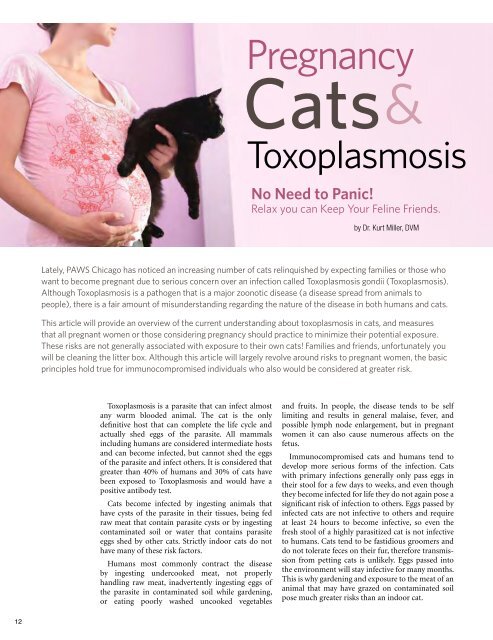paws-chicago-magazine-2011-winter
paws-chicago-magazine-2011-winter
paws-chicago-magazine-2011-winter
You also want an ePaper? Increase the reach of your titles
YUMPU automatically turns print PDFs into web optimized ePapers that Google loves.
Pregnancy&CatsToxoplasmosisNo Need to Panic!Relax you can Keep Your Feline Friends.by Dr. Kurt Miller, DVMLately, PAWS Chicago has noticed an increasing number of cats relinquished by expecting families or those whowant to become pregnant due to serious concern over an infection called Toxoplasmosis gondii (Toxoplasmosis).Although Toxoplasmosis is a pathogen that is a major zoonotic disease (a disease spread from animals topeople), there is a fair amount of misunderstanding regarding the nature of the disease in both humans and cats.This article will provide an overview of the current understanding about toxoplasmosis in cats, and measuresthat all pregnant women or those considering pregnancy should practice to minimize their potential exposure.These risks are not generally associated with exposure to their own cats! Families and friends, unfortunately youwill be cleaning the litter box. Although this article will largely revolve around risks to pregnant women, the basicprinciples hold true for immunocompromised individuals who also would be considered at greater risk.Toxoplasmosis is a parasite that can infect almostany warm blooded animal. The cat is the onlydefinitive host that can complete the life cycle andactually shed eggs of the parasite. All mammalsincluding humans are considered intermediate hostsand can become infected, but cannot shed the eggsof the parasite and infect others. It is considered thatgreater than 40% of humans and 30% of cats havebeen exposed to Toxoplasmosis and would have apositive antibody test.Cats become infected by ingesting animals thathave cysts of the parasite in their tissues, being fedraw meat that contain parasite cysts or by ingestingcontaminated soil or water that contains parasiteeggs shed by other cats. Strictly indoor cats do nothave many of these risk factors.Humans most commonly contract the diseaseby ingesting undercooked meat, not properlyhandling raw meat, inadvertently ingesting eggs ofthe parasite in contaminated soil while gardening,or eating poorly washed uncooked vegetablesand fruits. In people, the disease tends to be selflimiting and results in general malaise, fever, andpossible lymph node enlargement, but in pregnantwomen it can also cause numerous affects on thefetus.Immunocompromised cats and humans tend todevelop more serious forms of the infection. Catswith primary infections generally only pass eggs intheir stool for a few days to weeks, and even thoughthey become infected for life they do not again pose asignificant risk of infection to others. Eggs passed byinfected cats are not infective to others and requireat least 24 hours to become infective, so even thefresh stool of a highly parasitized cat is not infectiveto humans. Cats tend to be fastidious groomers anddo not tolerate feces on their fur, therefore transmissionfrom petting cats is unlikely. Eggs passed intothe environment will stay infective for many months.This is why gardening and exposure to the meat of ananimal that may have grazed on contaminated soilpose much greater risks than an indoor cat.12
















